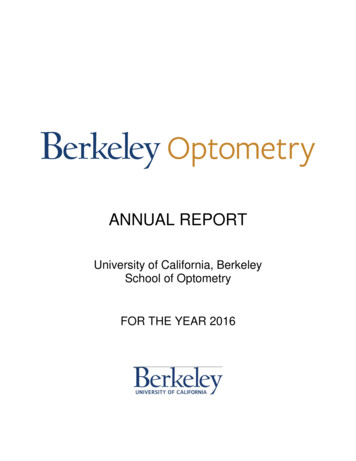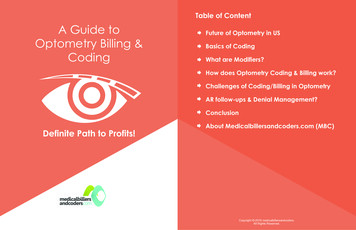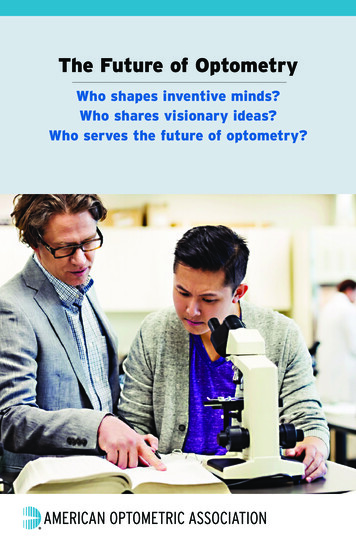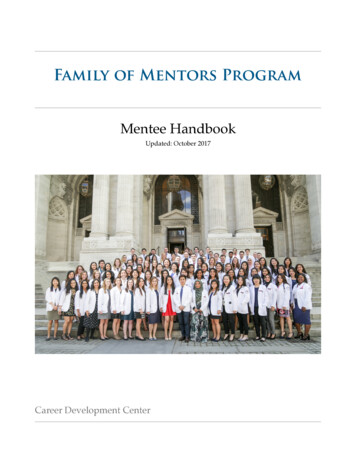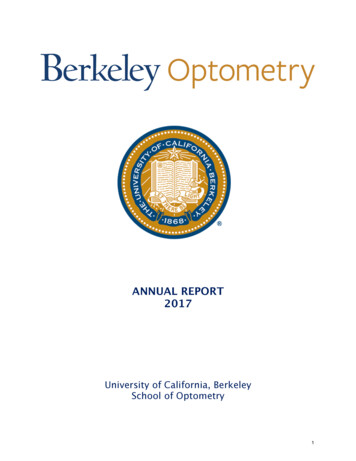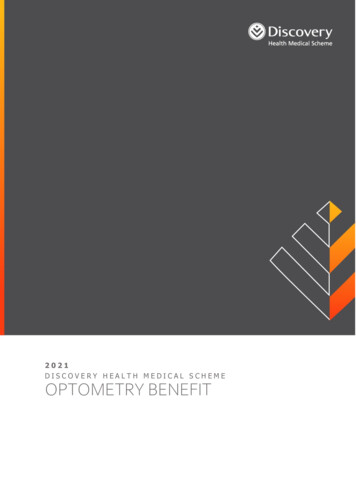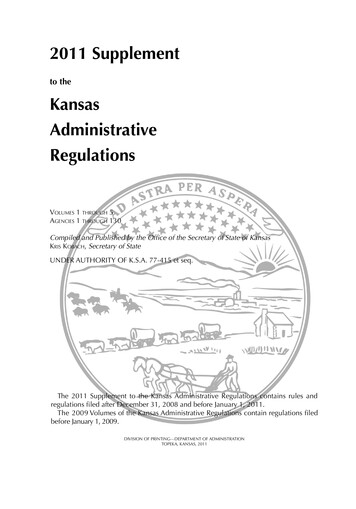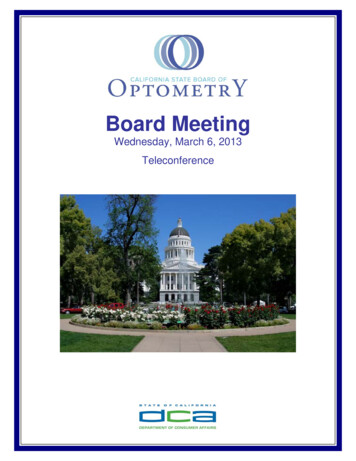
Transcription
Board MeetingWednesday, March 6, 2013Teleconference
STATE AND CONSUMER SERVICES AGENCY – Department of Consumer AffairsEDMUND G. BROWN JR., GovernorMEMBERS OF THE BOARDAlejandro Arredondo, OD, PresidentMonica Johnson, JD, Vice PresidentAlexander Kim, MBA, SecretaryDonna BurkeMadhu Chawla, ODFred Dubick, OD, MBA, FAOOGlenn Kawaguchi, ODWilliam Kysella, Jr.Kenneth Lawenda, ODBOARD MEETING AGENDAWednesday, March 6, 20139:00 a.m. – 11:00 a.m.(or until conclusion of business)California State Board of Optometry2450 Del Paso Road, Suite 105Sacramento, CA 95834(916) 575-7170 (directions only)And Via Teleconference at the Following Locations:Southern California Collegeof OptometryTVCI Room2575 Yorba Linda Blvd.Fullerton, CA 928313301 E. Main St., Ste. 1006Ventura, CA 93003140 C Tower St.Beaconsfield, QuebecH9W 6B2Kaiser/Dept. of Optometry5601 De Soto Ave.Woodland Hills, CA 913676035 Belleau W ood Ln.Sacramento, CA 958221919 S. State College Blvd.Anaheim, CA 92853808 Riverside Dr., Ste. 100Burbank, CA 91505ORDER OF ITEMS SUBJECT TO CHANGEFULL BOARD OPEN SESSION1.Call to Order – Roll Call – Establish a Quorum2.Sunset Review Report: Discussion of Questions/Comments from the Sunset Review Committeeand Approval of Responses to Questions/Comments3.Discussion and Possible Action Pertaining to California Code of Regulations (CCR) §1575,Uniform Standards Related to Substance Abuse and Disciplinary Guidelines4.Public Comment for Items Not on the AgendaNote: The Board may not discuss or take action on any matter raised during this public comment section,except to decide whether to place the matter on the agenda of a future meeting [Government Code Sections11125, 11125.7(a)]5.Suggestions for Future Agenda Items6.AdjournmentThe Board of Optometry’s mission is to serve the public and optometrists by promoting and enforcing laws and regulationswhich protect the health and safety of California’s consumers and to ensure high quality care.2450 Del Paso Road, Suite 105 Sacramento, CA 95834 (916) 575-7170 Fax: (916) 263-2387 www.optometry.ca.gov
Page 2 March 6, 2013 California State Board of Optometry Quarterly Board Meeting AgendaPUBLIC COMMENTS: Public comments will be taken on agenda items at the time the specific item is raised. Timelimitations will be determined by the Chairperson. The Board may take action on any item listed on the agenda,unless listed as informational only. Agenda items may be taken out of order to accommodate speakers and tomaintain a quorum.NOTICE: The meeting is accessible to the physically disabled. A person who needs a disability-relatedaccommodation or modification in order to participate in the meeting may make a request by contacting Krista Eklundat (916) 575-7170 or sending a written request to that person at the California State Board of Optometry, 2450 DelPaso Road, Suite 105, Sacramento, CA 95834. Providing your request at least five (5) business days before themeeting will help ensure availability of the requested accommodation.2450 Del Paso Road, Suite 105 Sacramento, CA 95834 (916) 575-7170 Fax: (916) 263-2387 www.optometry.ca.gov
Memo2450 Del Paso Road, Suite 105Sacramento, CA 95834(916) 575-7170, (916) 575-7292 Faxwww.optometry.ca.govTo:Board MembersDate:From:Alejandro Arredondo O.D.Board PresidentTelephone:Subject:Agenda Item 1 – Call to Order –Roll Call – Establishment of QuorumMarch 6, 2013(916) 575-7170Dr. Alejandro Arredondo, OD, Board President, will call the meeting to order and call roll to establish aquorum of the Board.Alejandro Arredondo, OD, Board President, Professional MemberMonica Johnson, JD, Board Vice President, Public MemberAlexander Kim, MBA, Board Secretary, Public MemberDonna Burke, Public MemberMadhu Chawla, OD, Professional MemberFred Dubick, OD, MBA, FAOO, Professional MemberGlenn Kawaguchi, OD, Professional MemberWilliam Kysella, Public MemberKenneth Lawenda, OD, Professional Member1 of 1
Memo2450 Del Paso Road, Suite 105Sacramento, CA 95834(916) 575-7170, (916) 575-7292 Faxwww.optometry.ca.govTo:Board MembersFrom:Mona MaggioExecutive OfficerSubject:Agenda Item 2 – Sunset Review Report: Discussion of Questions/Commentsfrom the Sunset Review Committee and Approval of Responses toQuestions/CommentsandAndrea LeivaPolicy AnalystDate:March 6, 2013Telephone:(916) 575-7170Background:The Board received a total of seven sunset issues that require a response to the Senate Committee onBusiness, Professions and Economic Development (Committee). Of the seven, the Board is being asked toaddress four (#1, #4, #5 and #6) at the Board’s Sunset Review hearing on Monday, March 11, 2013. Dr.Arredondo, Ms. Burke, Ms. Maggio and Ms. Leiva will be presenting before the committee. The following isan outline of how the Board will be reviewed.1) Dr. Arredondo and Ms. Burke will provide a short overview of the Board (5 minutes);2) Ms. Maggio and Ms. Leiva will respond to issues, problem areas, questions, and staffrecommendations (20 minutes);3) Public Comment (15 minutes);4) Comments by Professional Individuals, Groups or Associations (15 minutes); and5) Any closing comments by the Board (5 minutes).The hearing may need to continue on March 12, 2013. In the event the Board has to present on the secondday, Ms. Burke will be available to step in for Dr. Arredondo.Staff has completed draft responses to all issues for the Board’s consideration. Upon the Board’s approval,staff must finalize the responses and submit a final copy to the Committee.Senate Bill 304 (Price) has been introduced and proposes to extend the Board’s Sunset date from January1, 2014 to January 1, 2018. Staff anticipates the Board’s Sunset date will be extended.Action Requested:1) Staff requests that the members review, make edits, if any, and approve the Board’s draft Sunset Issueresponses.2) Staff requests that the members direct staff to finalize the draft Sunset Issue responses and submitthem to the legislature by the hearing date.1 of 1
BOARD OF OPTOMETRYRESPONSES TOCURRENT SUNSET REVIEW ISSUESMARCH 11, 2013The following are areas of concern for the Board to consider along with background informationregarding the particular issue. There are also recommendations the Committee staff have maderegarding particular issues or problem areas which need to be addressed. The Board and otherinterested parties, including the professions, have been provided with this Background Paper and areasked to respond to both the issues identified and the recommendations of the Committee staff.OCCUPATIONAL ANALYSISISSUE #1: What is the status of the occupational analysis for optometric assistants?Background: During the 2002 Sunset Review hearing, the JLSRC recommended that the Boardconduct an occupational analysis for optometric assistants to identify the tasks they will perform, andthe attendant training and skill level required. The JLSRC also requested that regulations clarifying thelevel of training and supervision of Optometric Assistants be promulgated.The Board indicated that they submitted a BCP in 2003 to obtain spending authority to conduct anoccupational analysis, but it was denied. Despite this, the Executive Officer presented proposedregulatory language and the Board voted to approve it. Unfortunately, due to issues with the timing ofthe proposed rulemaking package, the regulations were not enacted.The Board indicated that in 2009, it conducted an occupational analysis for the Board’s CaliforniaLaws and Regulations Examination and the National Board of Examiners in Optometry Examinationincluded data related to the knowledge that an optometrist must have pertaining to what tasks anoptometric assistant can perform.The Committee maintains the recommendation made by the JLSRC in 2002. Despite the occupationalanalysis for the national and state examinations in 2009, the Committee agrees that a specificoccupational analysis for optometric assistants is necessary.Staff Recommendation: In line with the recommendations made during the 2002 Sunset Reviewhearing, the Committee recommends that the Board take immediate action to conduct theoccupational analysis.Board Response: The Board agrees with the Committee’s recommendation and has already startedworking to obtain the funds necessary to conduct the occupational analysis. On January 25, 2013, theBoard met with the Department of Consumer Affairs’ Office of Professional Examination Services(OPES) to discuss the history of this issue, the project objectives and expected outcomes of anoccupational analysis for optometric assistants, the project plan (i.e., start dates, major events), and1 of 11
projected costs. The total projected OPES costs are 40,882.00. The Board’s projected costs are 25,828.92 . The total cost to the Board will be 66,710.92.The Board will work with DCA to draft a BCP to pay for the occupational analysis. If the proposal isapproved, work will begin in Fiscal Year 2014-2015. OPES’ proposed completion date is June 30,2015. At that time, the Board will review the results and OPES’ recommendations and determine nextsteps. Possible outcomes include developing regulations to implement the analysis’ recommendations,or the need to create a certification process under the Board’s oversight for optometric assistants. Thelatter outcome would require legislation and a permanent Staff Services Analyst.ENFORCEMENTISSUE #2: Should the Board check the Health Integrity and Protection Databank (HIPDB)and the National Practitioner Databank (NPDB)?Background: There are two national databanks related to disciplinary actions:1. NPDB: In 1987 Congress passed Public Law (PL) 100-93, § 5 of the Medicare and MedicaidPatient and Program Protection Act of 1987, authorizing the Government to collect informationconcerning sanctions taken by State licensing authorities against all health care practitionersand entities. Congress later passed the Omnibus Budget Reconciliation Act of 1990, PublicLaw 101-508, to add "any negative action or finding by such authority, organization, or entityregarding the practitioner or entity." Title IV is intended to improve the quality of health careby encouraging State licensing boards, hospitals, professional societies, and other health careorganizations to identify and discipline those who engage in unprofessional behavior; to reportmedical malpractice payments; and to restrict the ability of incompetent physicians, dentists,and other health care practitioners to move from State to State without disclosure or discoveryof previous medical malpractice payment and adverse action history. Adverse actions caninvolve licensure, clinical privileges, professional society membership, and exclusions fromMedicare and Medicaid.2. HIPDB: The Secretary of Health and Human Services, acting through the Office of InspectorGeneral and the U.S. Attorney General, was directed by the Health Insurance Portability andAccountability Act of 1996 to create the HIPDB to combat fraud and abuse in health insuranceand health care delivery. The HIPDB is a national data collection program for the reportingand disclosure of certain final adverse actions taken against health care practitioners, providers,and suppliers. The HIPDB collects information regarding licensure and certification actions,exclusions from participation in Federal and State health care programs, health care-relatedcriminal convictions and civil judgments, and other adjudicated actions or decisions asspecified in regulation.In its recent report, the Board indicated that it does not check HIPDB and NPDB prior to issuing orrenewing a license. The Board indicated the following reasons for not checking the databanks:1. Cost: “In order to initiate and maintain continuous queries when issuing and renewing licenses,the Board would need to raise the licensing fee. It is estimated that it would cost 6.50 perlicensee per year.”2 of 11
2. Staffing: “It is estimated that the Board would need an additional full time, limited term staffperson to manually enter licensees and applicants into the databanks.”The Committee is concerned with the protection of the public and the effective operation of theprofession. As such, it is imperative that methods, such as utilizing the NPDB and HIPDB, beemployed to thoroughly examine a potential licensee’s professional background and criminal history.Staff Recommendation: The Board should work with DCA to ensure that they are provided thefunds to apply for the NPDB and HIPDB.Board Response: The Board agrees with the Committee’s recommendation and will work with DCA’sBudget’s Office to determine the best method in obtaining the necessary resources. This may includedrafting additional BCPs for funds and staffing, or increasing licensing fees via legislation or theregulatory process.ISSUE #3: What has led to the time lag in cases referred to the Attorney General?Background: According to the Board’s recent report to the Committee, the Board’s performancetargets/expectations for its enforcement cases have extended considerably beyond the target timeframes.Despite the target of 90 days, for fiscal year 2010-2011, the average time required to complete theintake and investigation was 89 days. For fiscal year 2011-2012, the average time required tocomplete the intake and investigation was 184 days.Despite the target of 365 days for 2010-2011, the average time required to complete the entireenforcement process for cases resulting in formal discipline was 685 days. For the 2011-2012 fiscalyear, the average number of days was 879.The Board noted that the enforcement unit recently created internal timelines for each phase of acomplaint and participated in a training course with emphasis on effective time management. Theyindicate that the Board continues to request additional enforcement staff to help manage the caseload,but their requests “ continue to be denied by [DCA].”The Committee is encouraged by the recent efforts of the Board, but remains concerned that theBoard’s target timeframes are still being exceeded by a significant quantity. The Committee is alsoconcerned with the potential harm to the public that may be incurred if an unscrupulous licenseecontinues to practice during a lengthy disciplinary case review by the Attorney General.Staff Recommendation: The Committee recommends that the Board specify what additionalmeasures can be taken to expedite processing of enforcement cases.Board Response:When the Board takes disciplinary action in an enforcement case, the investigation has typically gonethrough a number of specific phases before that final disciplinary action is complete. While Board staffis directly responsible for the internal or “desk” investigation of any enforcement case, cases involving3 of 11
disciplinary action have typically been investigated in the field by sworn peace officers working forDCA’s Division of Investigation (DOI), often must be evaluated by an Expert Witness, and, finally,are referred to the Office of the Attorney General for assignment to a Deputy Attorney General (DAG)for the legal pleading and the final disciplinary action. The Board may have goals for the processing ofthe disciplinary actions, but DOI and the DAGs have their own time frames that they work with. Forexample, a DOI investigator is expected to complete an investigation within one year from the date it isassigned to them, and a DAG is expected to have a draft pleading to the Board within 90 days from thedate the case is assigned to them. Just these two time frames bring an investigation well over theBoard’s goal of 365 days and still doesn’t include the time required for desk investigation, ExpertWitness review, or the time between the receipt of a draft pleading and the effective date of a finaldecision, a time frame that includes filing of the pleading, waiting for a Notice of Defense, settlementnegotiations, possibly a hearing, review and adoption by the Board, and the thirty days between adecision’s order of adoption and the effective date of that decision.Board staff is exploring options for educating these outside agencies in regards to Optometry law andpractices in an effort to reduce the amount of time spent doing background research and learning aboutthe practice of Optometry. Board staff has also implemented the practice of contacting a DOIinvestigator or DAG upon case assignment to discuss the case, the work that needs to be done on thecase, and the options for resolving the case as quickly as possible. This has the added benefit of beingable to directly educate the assigned staff on the issues specific to the investigation at hand.The Board’s case load and the number of cases that the Board takes to disciplinary action are smallerthan the case loads of larger Boards, providing a statistical disadvantage wherein one or twoabnormally lengthy investigations are not sufficiently balanced by a number of more expedientinvestigations. While Board staff makes every effort to work cases as expeditiously as possible;investigations can require the assistance of offices and staff outside of the Board’s control. The internaltimelines that were recently created provide Board staff with a guide for follow up with agencies wecannot otherwise control. This follow up allows Board staff to become familiar with the outside staffworking with the Board’s case and allows Board staff to further express the urgency of theinvestigation.Board staff continually reassesses the priority of an investigation and expedite those cases that providea direct threat to the health and safety of the California consumer. The Board seeks Interim SuspensionOrders (ISO’s) and PC23 Orders where appropriate to more quickly restrict the license of potentiallydangerous licensees. The Board actively pursues stipulated settlements in disciplinary cases wheneverpossible in order to shorten the length of time before a final decision is effective, as well as reduce thecost to the Board of pursuing the disciplinary action.As was explained on page 58 of the Board’s Sunset Review Report, the Enforcement Statisticsreported included an almost 40% increase in case volume, as well as the repercussions of a technicalchallenge the Board faced during the implementation of a licensee mandate to submit to fingerprinting.When Board staff discovered the technical issue, there were a number of fingerprint results that had4 of 11
been held up and not received by the Board. Some of these fingerprint results included convictionhistories that needed to be investigated. Board staff made the decision to use the date that thefingerprint results were released to the Board by the Department of Justice (DOJ) rather than the morerecent date after the results were received by Board staff. This allowed for more technically accuratestatistics, but significantly elevated the case processing times shown in the statistics. Further, theprocessing of these fingerprint results took priority and the cooperation of all enforcement staff,limiting the ability of enforcement staff to prioritize the follow up of investigations that were in theprocess of being worked by DOI or the DAG.Finally, the Board is working towards some key changes that will help keep investigation timelinesshorter. Board staff has obtained additional Expert Witnesses and is working to recruit more.Previously, the Board had a limited pool of Expert Witnesses, which could cause delays in the receiptof Expert Witness reviews. An increased pool of Experts allows the Board to receive reviews morequickly by reducing the need to send multiple cases to a single Expert. The Board has also filled all ofits open positions in the Enforcement Unit, allowing the unit to operate at full capacity for the firsttime since the 2010/2011 fiscal year. While the new employees are still in the training process,improvements are already being seen in case statistics. Finally, the Board is in the process ofdeveloping requirements for the BreEZe database that are specific to the Board’s business processes.This is one of the final steps before the BreEZe team can begin the data transfer from DCA’s currentsystems to BreEZe. BreEZe is anticipated to reduce case investigation timeframes by allowing caseinformation to be transmitted electronically to and from DOI and the Board’s Expert Witnesses, aswell as to Board Members when a Board Vote is needed on a disciplinary matter. The ability totransmit this information electronically instead of making copies and putting it in the mail will save theBoard time and money, as well as decrease an investigation’s timeframe. The Board expects to beusing the BreEZe system in fiscal year 2013/2014.ISSUE #4: Should the Board be granted the authority to inspect an optometrist’s practicelocation?Background: The Board’s enforcement unit is charged with investigating and ensuringcompliance of the laws and regulations regarding optometry. However, these laws and regulationsdo not include the authority to audit and inspect an optometrist's practice location.Currently, if an inspection is required, the Board must enlist the assistance of the Division ofInvestigation, who as peace officers, have inspection authority. These investigators may enter anoptometric office and require the inspection of the premises including patient records, financial andbilling information, infection control procedures, etc. However, the investigators often are not awareof the specifics in regards to optometric offices, and may overlook important information, critical tothe investigation. The Board of Pharmacy, Board of Barbering and Cosmetology, Board ofRespiratory Care, Dental Board, and the Board of Physical Therapy are several of the health boardswithin DCA that have the authority to inspect the facilities in which their licensees practice. Theseinspections are to ensure the compliance of the laws and regulations of these boards, which in turn,protect California consumers.Inspection authority will allow the Board the ability to inspect and ensure compliance in thefollowing areas:5 of 11
Licensure - ensure that practicing optometrists have notified the Board of each practicelocation.License postings (usually posted in examination rooms, not visible to the general public).Infection Control -use of proper hand washing and other infection control procedures.Therapeutic and Ophthalmic Solutions -ensure expiration dates are being adhered to.Patient Charting -complete documentation, billing, and financial information.Business and Financial information - ensuring proper ownership, fictitious name and branchoffice licensure.The Committee is committed to public safety and enforcement of the profession. As such, theCommittee agrees that the Board’s enforcement unit should be granted the authority to inspect anoptometrist’s practice location. However, the Committee also notes the Board’s inability to carry outits current enforcement duties due to budget constraints and a lack of staff.Staff Recommendation: The Committee requests that the Board provide a plan for increasing theworkload of its enforcement officers considering the existing budget and staffing constraints.Board Response: In order for the Board to successfully implement inspection authority in a way thatwould benefit public safety, the Board would need to request a new position. The new position wouldhave to be an inspector classification, and the candidate would need to be an optometrist. The currentstaff at the Board is not qualified to perform inspection duties because they are not optometrists andare needed to perform the job duties they currently have. If current staff were to attempt to take on thisincreased workload, it would cause a negative ripple effect on all enforcement activities becausecurrent duties would be neglected. For example, enforcement processing timelines would increasewhich would result in less public protection. Also, since they are not specialists in practice relatedissues like an actual optometrist, it would be a waste of resources because they would not be aseffective as an optometrist. The Board of Pharmacy uses pharmacists in their investigation program,and the Board would most benefit from following the same model. The Board will need to submit aBCP to obtain the inspector position and spending authority, or an augmentation to our budget line tocontract with an optometrist to conduct inspections.In the meantime, the Board plans to continue handling cases that require an investigator the same waythey have been handled in the past. That involves enforcement staff conducting a desk investigationand identifying the types of violations that require an inspection. Then, Board staff requests thatinvestigator be sent into the field from the Department of Investigation (DOI). If DOI needs anoptometrist to develop an investigative plan, one of the Board’s experts will be called upon to assist.The Board will also meet with other healing arts boards that currently have inspection authority tolearn about and evaluate their programs. Based on the information collected from other programs, theBoard will develop its BCP and strengthen the justification for the need to obtain inspection authorityfor the profession of optometry.6 of 11
STAFFINGISSUE #5: Why was the Board’s budget change proposal (BCP) denied?Background: The Optometry Act provides authority for the Board to regulate the profession ofoptometry. The Board is charged with protecting its licensees and the consumers of optometricservices. Included in the Board’s basic authority is the ability for the Board to approve or denylicenses, take enforcement actions, pursue legislation, and conduct administrative duties.In its recent report to the Committee, the Board indicated that there have been various constraints thathave affected its ability to carry out its mandates. Specifically, the following deficiencies were noted:1. No participation in national organizations such as the ARBO and the COA.2. Inability to process licenses and fictitious name permits in a timely manner.3. Inefficiency processing and renewing applications.4. The Board does not check NPDB and HIPDB prior to issuing or renewing licenses.5. CE audits have not been consistently conducted.6. Performance targets for the enforcement program are not being met.7. No workforce development data has been collected.8. The Board is barely meeting its mandatory reporting requirements. During the last four fiscalyears, the Board only received a total of eight reports (BPC § 801(a), 802, and 803)The Board reported that these deficiencies are directly related to a lack of staff that would beresponsible for completing these salient tasks. Since 2010, the Board has lost almost all the muchneeded positions it gained throughout the years (six positions total) due to expiration of limited termpositions, DCA policy changes, and directives from the State and Consumer Services Agency andGovernor. The current management and staff structure does not provide for ongoing review ofprocesses to identify areas for process improvements and staff development. The Board noted in theirrecent report: “The Board is mandated to use its resources on the licensure, examination, andregulation of the profession of optometry. This also includes educating and protecting consumers.Without sufficient staff, funds and resources, this may result in the Board failing to meet its mandate,and inadequately giving California consumers the protection they deserve with a limited staff and agrowing profession, there are concerns as to whether staff can continue its current pace.”The composition of the Board’s staff since 2002 is noted in the chart below.TotalAuthorizedStaff PositionsTotal 110011416*1017 of 11201210.411.4**001
* This figure includes authorized position approved through BCPs but not filled, and two positionspaid from blanket funds.** This figure includes one position paid from blanket funds.The Committee is concerned about the Board’s ability to regulate the profession as they have limitedstaff which prevents them from performing essential tasks that will help ensure consumer protection.Staff Recommendation: The Board should inform the Committee of its plan to continue carryingout its various duties if no additional staff is allocated for the Board. The Board may want toexplore the possibility of hiring temporary or part-time staff to assist with completing critical tasks.Board Response: The Board agrees with the Committee’s recommendation to hire temporary or parttime staff to assist in the completion of critical tasks. Unfortunately, the Board has already exploredthis possibility and the Board’s budget does not have sufficient funding for re-direction of resourcesthat would support the hiring of temporary or part-time permanent staff.In an effort to continue carrying out the Board's various duties without additional staff the Board plansto take the following actions: Allow key staff to work 10 to 20 hours overtime per month for compensated time off to attemptto keep up with workload demands. Review duties in all units and reassign if possible. Conduct workload study of current employee duties to assist in the BCP process. The Boardneeds to determine the amount of employees needed in order for the program to function at itsmaximum capacity. Continue to assist the BreEZe development and implementation efforts. The goal of BreEZe isto streamline all licensing processes and assist with consumer complaints. The Board does wantto note that for the next six to eight months while staff is pulled to assist with this project, therewill be a delay in the processing and issuing of licenses and permits. Continue to utilize internal processing timelines in the enforcement unit for the processing andmanaging of complaints from receipt to investigation and discipline. Develop internal processing timelines similar to the enforcement unit for th
California State Board of Optometry 2450 Del Paso Road, Suite 105 Sacramento, CA 95834 (916) 575-7170 (directions only) And Via Teleconference at the Following Locations: Southern California College 3301 E. Main St., Ste. 1006 . 1919 S. State College Blvd. of Optometry Ventura, CA 93003 Anaheim, CA 9285 TVCI Room
